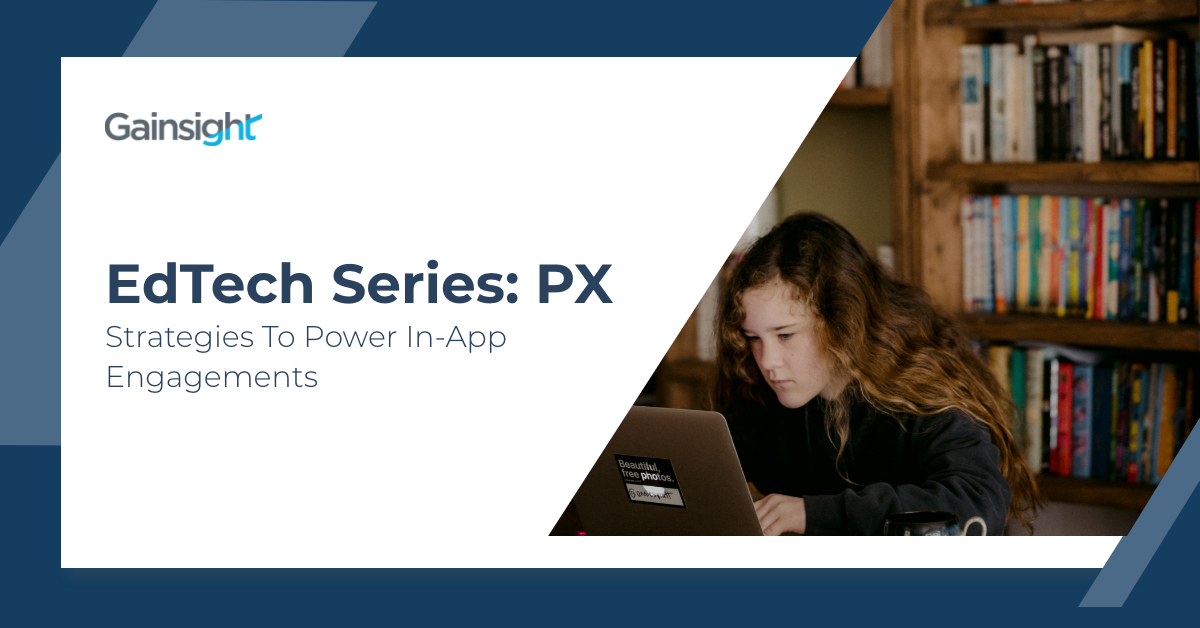In EdTech, where communication is critical, how do you make sure the right message reaches the right students, teachers, administrators, and other educational players?
Amidst the end of the school year, graduation chaos, and planning for the next school year, educators have not only been bombarded by every email subscription list they’ve ever signed up for but also marketing campaigns from new and old EdTech companies. Inboxes are ticking higher and higher as different states, districts, and schools message how they will accommodate educating students during COVID-19, and every other business rushes to send communications on addressing this “new normal.” If you needed to get important information to your users, it was likely buried under all of these communications.
As the situation surrounding COVID-19 continues to evolve, companies need to be prepared to keep all their end-users informed. In this guide for EdTech products, we’ll show you how to use in-app engagements to cut through the noise and effectively communicate information to all your end-users when time is of the essence.
What Is an In-App Engagement?
In-app engagements are outreaches from your company to your end-users that happen within a product. In times like these, they can be used to:
- Provide critical updates
- Enable quick onboarding
- Drive ongoing product education that evolves with current events
- Capture user sentiment
- Examples of in-app engagements include onboarding tours, new feature releases, content announcements, and surveys.
An in-app engagement strategy requires two things: structure and technology. Technology is necessary to deploy the in-app engagements and the processes below will help you map out when, where, and how often your engagements should occur.
Why Are In-App Engagements so Important Right Now?
We’re experiencing something we never have before—coronavirus, global quarantines, social distancing, and the economic impacts that come with them. This has affected everyone, especially educators, and the technology they use every day.
Your product is the best way to share important information with your users. In-app engagements allow you to create hyper-targeted messages so you can inform students, parents, educators, and administrators.
What Your End Users Expect: Students and Parents
You need to provide a smooth experience for these users and help them get the information they need.
In industries like education, you’re getting a lot of new people signing up to use your services. Simultaneously, you need to relay important updates surrounding COVID-19 and share what to expect right now and in the future. Set up expectations upfront to make the experience more positive for everyone. Creating excellent COVID-related copy templates is the first step toward communicating with your students, parents, teachers, and administration.
What Your End Users Expect: Teachers and Administrators
You need to create a quick, efficient experience that allows teachers and administrators to complete their workflow. It’s critical that the engagements going to them are concise and hyper-relevant.
They are busier than ever, so providing in-app documentation and ways for them to find the information they need quickly is paramount. In-app onboarding guides are also important so new users can ramp up ASAP. If there are new protocols, this is also a time to provide in-app tours to keep educators up-to-date with the necessary workflow.
Creating a Compassionate In-App Engagement Strategy
Before you start sending out in-app engagements left and right, you need to be able to triage all the high-priority information and make sure the most important, relevant information reaches your end-users.
The keyword here is “compassionate.” In reality, we’re not just reaching out to “users,” we’re reaching out to people. These people are busy or anxious or stressed or all of the above. Your actions and communications are a positive, proactive way for you to help users through it all.
The processes below are intended to put humans first—it’s about what the end-user needs to see, not what will most benefit the company’s bottom line. However, doing one will impact the other. Use these best practices below to set up in-app engagement processes that will create long-term value for your users and your company.
Creating a Hierarchy of Importance
When you’re behind the product trying to help your users achieve success, it seems like every in-app message is necessary. But no matter how relevant and perfectly-timed they are, send too many in-app comms and your users are going to get fatigued. You can’t risk this when there are so many changes going on in the world that affect education, your product, and your users.
At Gainsight, we have a hierarchy for our in-app engagements. This helps avoid the “loudest voice wins” dilemma. Now if a department requests an in-app engagement (i.e. webinar promotion, event registration, feature announcement, etc.) we can definitively say which one takes priority. We’ve modified this to include situations that might occur in a time of crisis.
In-app engagements in order of priority (highest to lowest):
- Critical Health/Wellbeing Announcements
- Product Announcements: Specific to Current Events
- Product Adoption: Specific to Current Events
- Content Announcement: Specific to Current Events
- Product Adoption: General Usage, Onboarding
- Education
- Product Feedback
The TRUSt Framework for In-App Engagements
Every in-app communication must have a purpose. When things are business-as-usual, each in-app engagement needs to inform the user of important product information and/or help them get more value out of their partnership. In times of crisis, you also need to make sure that you’re getting time-saving, and potentially highly impactful information to people that need it.
At Gainsight, we created “The TRUSt Framework” to ensure that all in-app engagements are done with intention. As you create and schedule each engagement, ask yourself:
Is It Timely? Engagements are presented based on the user’s timing, not ours. This is especially critical in education where you don’t want to disrupt educators during critical workflows.
Is It Relevant? Engagements must be triggered based on clear use of our product (or lack of use within a reasonable amount of time) and related to a user’s role in our products. In education, a single user can play multiple roles such as teacher, administrator, and parent. Consider segmenting by district or school size to ensure these types of users don’t get inundated with engagements meant for the many roles they play.
Is It Useful? Engagements must help users in some way, such as learn something new or complete a task faster.
Is It Straightforward? Be clear and concise—“Verbosity is the enemy.”
CLICK HERE TO DOWNLOAD THE IN-APP ENGAGEMENT KIT
Creating an In-App Engagement Approval Process
You need a tight approval process if you want in-app engagements to be published swiftly and accurately. The optimal in-app engagement approval workflow will include all of the following components. However, there are moments in time where immediate action is needed. We’ve included suggestions for ways you can expedite this process in times where messages are urgent and must be streamlined.
Step 1: Initial Review
To avoid a negative user experience, engagements at Gainsight follow a defined approval process. Only certain teams (i.e. Customer Success Operations, Marketing Operations, and Product Documentation) have access to the in-app engagement creator in Gainsight PX. All submissions require the following components for initial review:
- Content (message, text, and graphics)
- Target audience
- Type of in-app engagement (lightbox, survey, tooltip, etc.)
- Business use case
- Desired outcome
- Desired start date
- Duration of campaign
- Frequency of appearance
- Having a dedicated group with members from different departments adds checks and balances.
Expediting the Review Process
Narrow down the number of stakeholders involved in the process to the most relevant teams and make it clear to them that reviewing/approving in-app engagements are a high priority.
Step 2: Establishing an Approval Committee
At Gainsight, once a teammate submits a request for a new in-app engagement, it’s reviewed by our In-App Engagement Steering Committee. The departments represented in your committee should be the ones who have the most accountability for the success or failure of these engagements. Our internal steering committee is composed of a member from each of the following departments:
- Marketing: They are well aware of the demand generation content calendar and upcoming events, webinars, and blog posts, as well as brand voice and guidelines. They help align in-app engagements with campaigns they may be running during the same time period.
- CS Operations: They have deep customer insight and have access to immediate customer feedback. They’re responsible for an in-app engagement content calendar that tracks all approved engagements, the audience, and durations. This calendar helps avoid messaging conflicts and audience fatigue from too many engagements.
- Product Operations: This member can give insight on upcoming features, keep everyone aligned.
- Documentation: A key part of customer communications, they should have visibility on what sort of guides and walkthroughs are being shared with customers to ensure consistency.
- Once an engagement is approved and added to the calendar, account managers should be informed of the campaign so they can follow up with their accounts. This helps ensure that your in-app engagement reaches maximum effectiveness.
Expediting the Committee Approval Process
If you’re optimizing your process for urgent communications, you’ll want to narrow this committee down to just a member of Marketing, a member of Product, and the operations team in charge of deploying the engagement. Depending on the size of your team, you could even put this in the hands of a marketing team member that has the ability to deploy the engagement.
How Are You Communicating With Your Users?
In-app engagements are incredibly powerful tools. They’re an important part of driving adoption and can have a serious impact on retention. The more people find value from your new and existing features, the more they’ll return. They also boost confidence and create healthy habits in your users. But unless you are able to properly prioritize engagements, they’ll hurt more than they help.
The frameworks and processes that you put in place now to address the sharing of critical information, will provide ongoing value. The best practices in this article will help you build a solid foundation for your in-app engagement strategy this year and beyond. Please reach out to us here for more resources as you continue to create a compassionate product experience for your students, teachers, administrators, parents, and staff!

